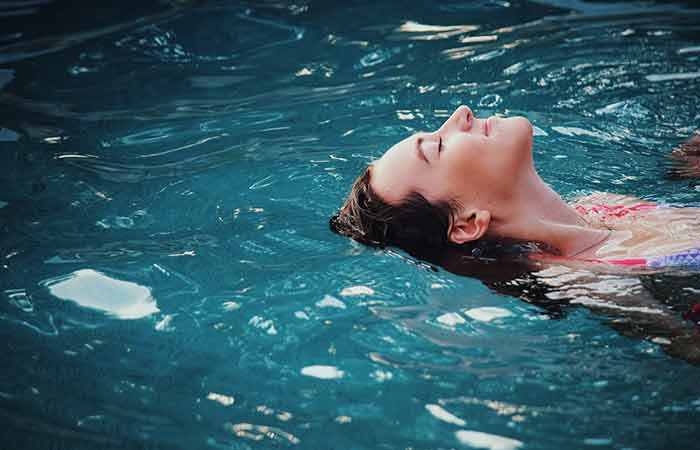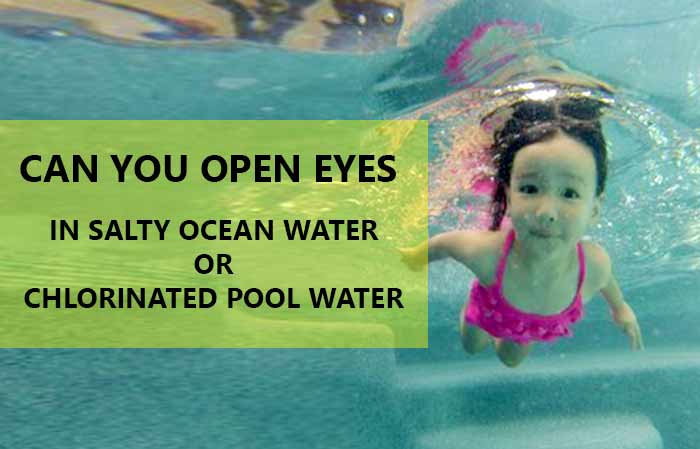Neoprene Swim Caps -Pros, Cons and More!
Neoprene caps are a unique option that offers superior warmth and insulation for individuals who regularly swim in cold waters.
In this comprehensive guide, we’ll explore the ins and outs of neoprene swim caps, including their pros and cons, styles, best in the market, buy guide, proper care frequently asked questions, and more.
Neoprene Pros and Cons
Neoprene swim caps /skull caps are specially designed headgear made from a material called neoprene. Neoprene is a synthetic rubber that is known for its excellent insulating properties and flexibility. It is commonly used in wetsuits and other water sports gear due to its ability to provide more thermal protection compared to lycra/spandex, latex or silicone caps.
The structure of a neoprene swim cap is typically smooth on the outside and has a soft, cushioned texture on the inside. It is designed to fit snugly.
The main function of a neoprene swim cap is to keep your head warm while swimming in cold water. Neoprene acts as an effective insulator, trapping a thin layer of water between the cap and your head. Your body heat quickly warms this layer of water and forms a barrier against the cold water.
By maintaining this warm layer, the swim cap helps to regulate your body temperature and prevent excessive heat loss through the head, which is a sensitive area prone to heat loss.
Neoprene is a thick, insulating synthetic rubber material also used for wetsuits.
Pros
Here are the major benefits you’ll enjoy with a neoprene swimming cap:
- Extreme warmth – Neoprene caps keep your head and ears significantly warmer than other cap materials thanks to their insulating properties. It traps body heat close to your head.
- Durability – Neoprene is thick and tough, making these caps very long-lasting. They resist ripping, punctures, and deterioration from pool chemicals better than thin latex or silicone.
- Buoyancy – Neoprene has natural buoyancy and will float in water, unlike latex or silicone caps which sink. This makes retrieving a lost neoprene cap easier.
- Style – Neoprene caps come in vivid colors and fun patterns for a bold look. Their thick material shows off prints and colors nicely.
- Hydrodynamic advantage: Neoprene caps create a smooth surface, reducing drag and ensuring you glide in the water effortlessly
- The snug fit of the cap helps keep your hair in place and prevents it from obstructing your vision while swimming.
- Some neoprene swim caps also provide added ear protection, reducing the risk of water entering the ears
Neoprene is simply unmatched for insulation in chilly water. The material also resists stretching out and withstands frequent use for years if cared for properly. If you love swimming year-round or in open water, a neoprene cap is a smart choice.
Further Reading: Why Every Swimmer Needs to Wear a Swim Cap
Cons
Here are some downsides of neoprene swim caps.
- Limited breathability: Neoprene caps may restrict airflow to the head, hence causing discomfort for some swimmers.
- Not suitable for warmer water: The insulation properties of neoprene may cause overheating in warmer swimming waters.
- Hair compression: Neoprene caps can compress hair, resulting in compressed hairstyles after your swimming routine.
- Limited stretch that makes sizing confusing
- Slightly expensive compared to latex and silicone caps
Types/Styles
Here are the main types and styles of neoprene swim caps:
| Cap Style | Description | Coverage | Warmth Level |
| Full Neoprene | Covers entire head, ears, neck | Full | Maximum |
| Split Panel | Neoprene sides, open crown | Moderate | Moderate |
| Open Back | Neoprene front, sides, top | Front & Top | Good |
| High Neck | Extends up back of neck | Moderate | Very Good |
| Chin Strap | Adjustable neoprene strap | Moderate | Moderate |
| Skull Cap | Resembles winter beanie | Top & Sides | Good |
| Wetsuit Hood | Seals neck and head fully | Full | Maximum |
Consider water temperature and your needs for warmth vs. mobility when selecting a neoprene cap style. Combine features like chin straps or high necks for even more insulation.
The Best Neoprene Swim Caps
Here are some of the top neoprene caps for open and cold water swimming.
1. Blueseventy Adjustable Thermal Swim Cap
At the top of our list is the Blueseventy adjustable thermal swim cap that is expertly constructed using a 3mm Yamamoto neoprene, which has been coated with SCS (Super Composite Skin) for enhanced durability and hydrodynamics.
An exceptional feature of this swim cap is its full zirconium lining, a material commonly used in the construction of Thermal Reaction wetsuits. This remarkable addition serves a vital purpose since it is renowned for its excellent heat retention capabilities, allowing it to trap and maintain warmth effectively.
Apart from that, this swim cap has a flexible central panel, designed to enhance the overall fit of the cap. This flexible panel allows the cap to conform to the unique shape of your head, ensuring a snug and comfortable fit.
It also has a chin strap that can be easily adjusted to your preferred tightness. With the adjustable strap, you can swim with confidence, knowing that your cap will stay securely in place throughout your training session or competition, allowing you to focus solely on your performance.
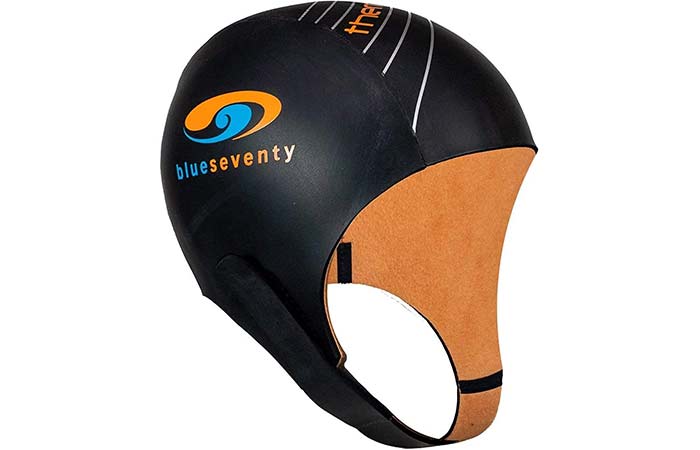
Pros
- Provides exceptional insulation in open water and cold water swimming.
- Comfortable and well-designed, ensuring a snug fit.
- Adjustable strap with velcro closure allows for a personalized fit.
- Durable and long-lasting neoprene material.
Cons
- Straps can come loose over time requiring constant readjustment
- Water soaks your hair.
- Difficult to squeeze into if sizing is inaccurate.
2. Zone3 Neoprene Swim Cap
Zone3 Swim Caps are designed to address a common concern among users regarding the tightness and lack of adjustability in most neoprene swim caps.
This cap has a velcro strap under the chin to accommodate different head sizes providing swimmers with a comfortable fit.
To even further fit and comfort, this cap is available in three sizes, each catering to specific head circumferences. It comes in small, medium, and large sizes for head circumferences below 21 inches, between 21 to 22 inches, and above 22 inches respectively.
In addition to its exceptional comfort, the cap is expertly crafted using a premium 4mm Yamamoto Smoothskin material. This high-quality material ensures a snug and comfortable fit and provides remarkable warmth and excellent water tightness.
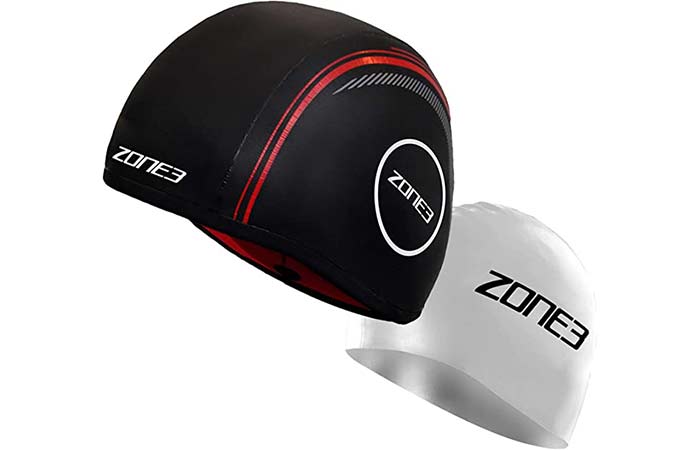
Pros:
- It fits well and is comfortable to wear.
- The 4mm material provides effective insulation to prevent brain freeze.
- Easy to use.
- Excellent quality.
- It helps keep the head warm and protects the ears.
- It can be worn over a swim cap for added warmth.
Cons:
- Not recommended for swimmers with thick hair.
- Open back is less insulating than full coverage.
- Velcro strap can snag hair and be tricky to line up perfectly.
3. TYR High-Visibility Neoprene Swim Cap
Crafted with a combination of 80% polyester and 20% spandex, this cap is designed to provide exceptional performance and durability. The cap has a PU coating that not only enhances its durability but also helps retain body heat, making it the perfect choice for open-water fitness regimens and triathlon training.
With its perfect fit, the TYR Hi-Vis Neoprene Swim Cap reduces the drag effect in the water, allowing you to glide through with ease. The tear-resistant construction also ensures that this cap will withstand vigorous use without going bad easily.
Additionally, it comes in bright, high-visibility colors that ensure swimmers remain visible in the water, ensuring safety during training sessions and competitions in wide swimming areas.
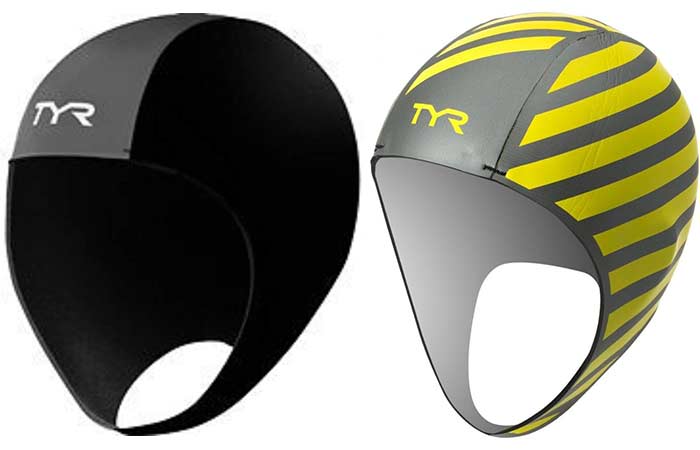
Pros:
- Nice fitting cap, providing a snug fit in the water.
- It offers good insulation, keeping the head warm even in 60°F water.
- It has a high-visibility color pattern, making it easy to be seen by swim partners and others.
- Suitable for individuals with smaller heads.
- Easy to adjust with a strap under the chin.
Cons:
- Users have reported that the cap gets smaller in the long run.
- Not made of neoprene but rather foam material, which may affect performance.
Synergy Neoprene Smoothskin Swim Hood
This swim cap is built with superior performance in mind.
It covers the ears and head from brow to neck and has a very comfortable and soft neoprene chin strap.
This Snug fitting hood-style cap provides excellent heat retention and insulation.
Key Features
- SCS coated smoothskin for low friction
- 2.5 mm Yamamoto SCS Smoothskin Neoprene.
- Soft inside for added comfort
- Flexible chin straps for easy breathing and comfort
- Reflective logo for safety
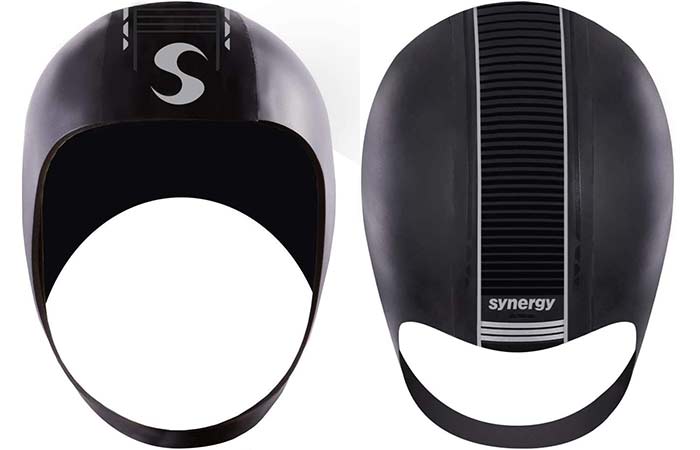
Pros
- Available in multiple sizes
- Versatile-can be used by swimmers, divers, surfers and triathletes worldwide.
- Lightweight
- Safety feature
- Easy breathing
Cons
- Thinner neoprene lacks insulation of 5mm caps
- Not ideal for extremely chilly waters
- Available in only one color
- No-adjustable strap
Xterra Performance Swimming Cap for Men, Women, & Kids
Carefully designed, crafted and tested in San Diego, California, the XTERRA Cap is made for the sun, water, and your elite training regimen.
It delivers a decent level of warmth from its 2mm neoprene construction.
Available in two sizes this neoprene swim hat comfortably fits most adult head sizes, even if you have long hair, natural hair, or dreadlocks.
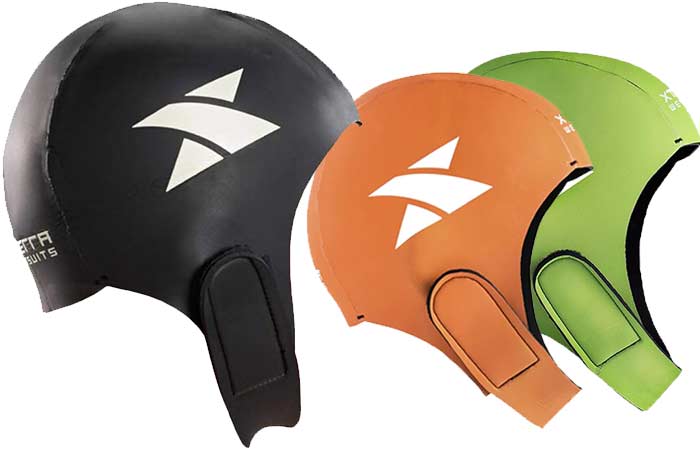
Key Features
- 2mm premium neoprene material
- Chin strap for a secure fit
- Flatlock stitching to reduce chafing
- Available in multiple colors (black, greenish, and orange)
Pros
- Provides good warmth
- Chin strap helps keep the cap in place
- Smooth flatlock stitching prevents irritation
- Works well for cooler open-water swimming
Cons
- Thinner 2mm neoprene lacks insulation of 5mm caps
- Not ideal for freezing waters
- A couple of sizing and fitting challenges
Buying Guide for Neoprene Swim Caps
To choose the right neoprene swim cap, there are a few key factors to keep in mind.
Fit and size options: Precise fit ensures warmth retention and security while swimming. Measure your head and consult sizing charts. Too loose and warmth escapes. Look for a swim cap that offers different size options or an adjustable strap
Thickness and insulation level: Consider the thickness of the neoprene material used in the cap. Choose 1-3mm thickness for cool water, or 5mm and up for extreme cold water swimming. Thicker caps provide better insulation and help retain body heat, which is especially important for swimming in colder waters.
Coverage – Opt for full head coverage over open back caps for retaining the most body heat. Open backs may be comfortable but lose heat.
Design and style preferences: Choose a design that suits your taste. Whether you prefer a solid color, a vibrant pattern, or a specific shape, plenty of options are available to match your style. Neoprene shows off vivid colors and fun patterns nicely, especially when wet.
Other features to look for
- Edge construction: Look for swim caps with sturdy and well-stiched edges. This ensures durability and helps prevent any discomfort or irritation during your swim.
- Adjustable straps: Consider caps with adjustable straps that allow you to customize the fit for added comfort and security. This helps keep the cap in place and prevents it from slipping off during your swim.
- Additional functionalities: Some neoprene swim caps come with added functionalities, such as ear protection. These caps are designed to keep your ears warm and shielded from cold water, which can be beneficial in cold swimming conditions.
Bonus Tip!
It’s always a good idea to research the about reputation of the brand of your choice and read customer reviews before making a purchase. This can give you insights into the quality and performance of the swim cap, helping you make an informed decision.
Putting On and Taking Off a Neoprene Cap
Getting a snug neoprene cap on and off takes a little finesse:
- Apply a non-petroleum jelly like Vaseline inside the cap and on your forehead for ease of entry and removal. This lubricates without damaging the neoprene.
- Stretch gently with both hands before pulling the cap over your head to prevent painfully tugging hair. Never force a tight cap on.
- Remove the cap slowly and carefully to avoid any hair pulling. Roll cap off versus yanking straight up.
Note: The jelly lets the cap glide over wet hair without sticking or pulling. Take your time removing the cap to avoid discomfort. Rinse any leftover lubricant after swimming.
Further Reading
How to Put on a Swim Cap Properly + Pro Tips for Long Hair
How to Care for Neoprene Swim Caps
Caring for your neoprene swim cap is essential to ensure its longevity and performance. Here are some simple and practical tips to keep your neoprene swim cap in great condition:
Cleaning
After each use, rinse your swim cap with clean water to remove chlorine, salt water, or any other residue that can degrade neoprene.
Gently squeeze out the excess water and allow it to air dry. Avoid using harsh chemicals or abrasive cleaners as they can damage the neoprene material.
Allow air-drying fully turned inside out before storage so the inner layer dries too
Storage
Store the cap in a cool and dry place away from direct sunlight and heat which can damage neoprene over time.
When storing avoid
- Contact with oils, lotions, and cosmetics that can stain or compromise the integrity of the neoprene material.
- Storing it in tightly packed bags or compartments to maintain its shape and integrity.
- Folding or creasing the cap, as it may affect its shape and fit.
Replace yearly or sooner if the cap becomes loose, worn, faded from sunlight, or otherwise damaged. A compromised cap loses warmth.
Neoprene Swim Caps Vs Latex and Silicone caps
Neoprene caps are superior for warmth and durability but can be tricky to size and put on due to its limited stretch. On the other hand, latex caps are cheap but lack warmth and tear frequently while silicone caps strike a balance with decent stretch, water repellency, and longevity
Here is a detailed comparison table
| Feature | Neoprene | Latex | Silicone |
| Warmth | Excellent insulation, retains body heat | Minimal warmth, water cools head | Better than latex, but less than neoprene |
| Durability | Very durable material, lasts years | Can tear easily, lifespan under 1 year | Decent lifespan of 1-2 years |
| Stretch | Hardly stretches, retains fit | Very high stretch, can become loose | Moderate stretch, will loosen slightly |
| Water Repellency | Repels water well, delays seepage | Absorbs water, soaked quickly | Sheds water at first, but absorbs over time |
| Buoyancy | Floats in water, easy to retrieve | Sinks immediately | Sinks immediately |
| Ease of Use | Must stretch to pull on, can catch hair | Very easy to put on and remove | Easy on and off, may tug hair slightly |
| Cost | Most expensive cap option | Least expensive option | Mid-range cost |
| Purpose | Ideal for cold water swimming | Best for pool/lap swimming | Improved latex cap for mild cool water |
From the above details, neoprene offers unique advantages the other two cap materials can’t match. Only neoprene provides superior insulation.
Further Reading: Best Swim Caps for ALL Hair Types
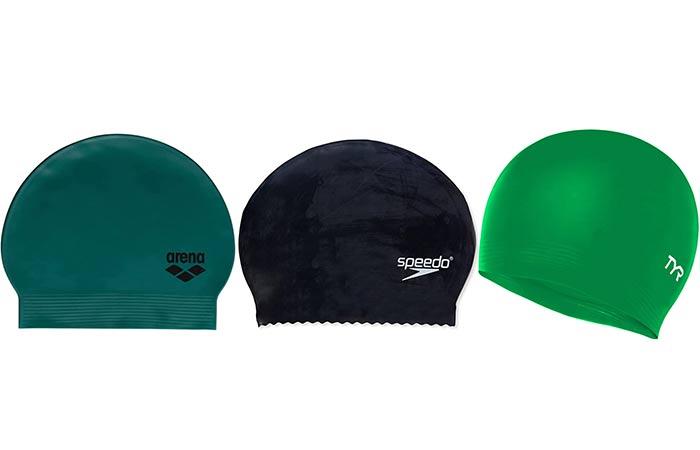
FAQs
Here are some common frequently asked questions about neoprene swim caps:
How much warmer is a neoprene cap compared to latex or silicone?
Neoprene caps can be up to 20 degrees Fahrenheit warmer than latex or silicone caps. The insulating neoprene material traps body heat much more effectively.
What thickness of neoprene cap should I get?
For mild cool water, 2-3mm is sufficient. For very cold water down to 40 degrees F, choose a 5mm thickness cap for maximum insulation
How tight should a neoprene cap fit?
It should fit snugly over your head and ears, but not be painfully tight. If you have to tug excessively hard to get it on, size up. A loose cap loses warmth.
Can I put a neoprene cap in the washing machine?
No, hand wash only. Machine washing can damage the neoprene material. Rinse thoroughly after use and allow to air dry
How do I get a neoprene cap on without pulling my hair?
Wet your hair first. You can apply a small amount of conditioner or non-petroleum jelly on your forehead to help the cap slide on smoothly.
Do neoprene caps come in different styles?
Yes, you can find full head coverage, open back, adjustable strap, high neck, and split panel options to suit your preferences.
Should I take my neoprene cap off immediately after swimming?
Yes, rinse the cap thoroughly after use and remove it. Leaving neoprene against your skin for extended periods can cause irritation.
How long does a neoprene cap last?
With proper care, a neoprene cap should last 1-2 years before needing replacement from stretching out or wearing thin.
Can I use a neoprene cap for hot tubs or saunas?
No, only use it for cool or cold water swimming. The insulation traps heat making neoprene caps unsafe for hot water
Sources
- https://www.cdc.gov/disasters/winter/staysafe/hypothermia.html
- https://www.csusm.edu/surfresearch/documents/smith-2020.pdf
- https://sewport.com/fabrics-directory/neoprene-fabric
- https://www.ncbi.nlm.nih.gov/pmc/articles/PMC6628109/
- https://www.blueseventy.com/blogs/stories/conquer-the-cold-water


